二十世纪英美文学流派名词解释
- 格式:doc
- 大小:51.00 KB
- 文档页数:3
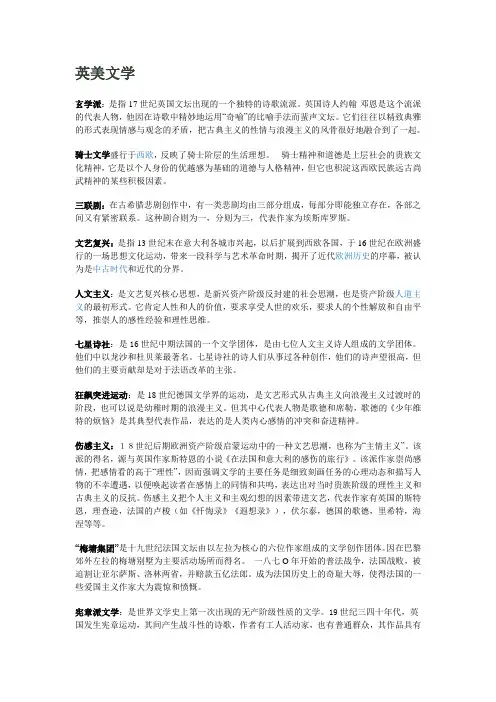
英美文学玄学派:是指17世纪英国文坛出现的一个独特的诗歌流派。
英国诗人约翰·邓恩是这个流派的代表人物,他因在诗歌中精妙地运用“奇喻”的比喻手法而蜚声文坛。
它们往往以精致典雅的形式表现情感与观念的矛盾,把古典主义的性情与浪漫主义的风骨很好地融合到了一起。
骑士文学盛行于西欧,反映了骑士阶层的生活理想。
骑士精神和道德是上层社会的贵族文化精神,它是以个人身份的优越感为基础的道德与人格精神,但它也积淀这西欧民族远古尚武精神的某些积极因素。
三联剧:在古希腊悲剧创作中,有一类悲剧均由三部分组成,每部分即能独立存在,各部之间又有紧密联系。
这种剧合则为一,分则为三,代表作家为埃斯库罗斯。
文艺复兴:是指13世纪末在意大利各城市兴起,以后扩展到西欧各国,于16世纪在欧洲盛行的一场思想文化运动,带来一段科学与艺术革命时期,揭开了近代欧洲历史的序幕,被认为是中古时代和近代的分界。
人文主义:是文艺复兴核心思想,是新兴资产阶级反封建的社会思潮,也是资产阶级人道主义的最初形式。
它肯定人性和人的价值,要求享受人世的欢乐,要求人的个性解放和自由平等,推崇人的感性经验和理性思维。
七星诗社:是16世纪中期法国的一个文学团体,是由七位人文主义诗人组成的文学团体。
他们中以龙沙和杜贝莱最著名。
七星诗社的诗人们从事过各种创作,他们的诗声望很高,但他们的主要贡献却是对于法语改革的主张。
狂飙突进运动:是18世纪德国文学界的运动,是文艺形式从古典主义向浪漫主义过渡时的阶段,也可以说是幼稚时期的浪漫主义。
但其中心代表人物是歌德和席勒,歌德的《少年维特的烦恼》是其典型代表作品,表达的是人类内心感情的冲突和奋进精神。
伤感主义:18世纪后期欧洲资产阶级启蒙运动中的一种文艺思潮,也称为“主情主义”。
该派的得名,源与英国作家斯特恩的小说《在法国和意大利的感伤的旅行》。
该派作家崇尚感情,把感情看的高于“理性”,因而强调文学的主要任务是细致刻画任务的心理动态和描写人物的不幸遭遇,以便唤起读者在感情上的同情和共鸣,表达出对当时贵族阶级的理性主义和古典主义的反抗。


二十世纪文学名词解释(一)现代主义1.现代主义(先锋派文学)2.后期象征主义3.未来主义4.超现实主义5.表现主义文学6.叙事剧与间离效果7.意识流小说8.存在主义文学9.荒诞派戏剧10.新小说派11.黑色幽默12.魔幻现实主义13.卡夫卡小说14.境遇剧1.现代主义是十九世纪末二十世纪初以来在欧美出现的各种文学艺术思潮流派的总称(1分)。
它是西方垄断资本主义时代的产物,从不同角度反映了现当代资本主义社会的危机与人的精神迷惘、困惑(1分)。
在思想内容、审美追求与表现形式上都表现出反传统的倾向。
具有标新立异、大胆实验、追求奇异的风格特点。
故称为先锋派、实验派。
重要流派有:超现实主义、意识流小说、荒诞派戏剧等(1分)。
2.二十世纪二十年代以瓦雷里、里尔克、艾略特为代表的诗歌流派(1分),是十九世纪末象征主义的继续和发展。
创作上主张用象征、暗示、意象、比喻、自由联想等手法表现微妙复杂的体验与主观感受(2分),较前期象征主义更趋哲理化与神秘性(1分)。
代表作家作品:艾略特《荒原》、里尔克《杜伊诺哀歌》(1分)。
3.二十世纪源于意大利,影响整个欧洲的诗歌流派(1分)。
其基本特征是:否定一切,主张彻底废除一切艺术遗产与传统文化,主张变革,歌颂混乱、速度美、力量美,用自由不羁的语句颠覆传统艺术规范,具有虚无主义、无政府主义倾向(2分)。
代表人物:马里内蒂、帕拉采斯基(1分)。
4.两次世界大战期间源于法国影响欧美的文学流派(1分),主张表现超现实、超理性的无意识心理、梦幻世界,用纯精神的自动反应进行写作(2分)。
最大限度展示自我的内在真实。
具有神秘晦涩的特点(1分)。
主要代表人物有布勒东、阿拉贡、艾吕雅(1分)。
5.第一次世界大战后源于法国影响欧美的现代主义文学流派(1分),创作上强调表现主观感受,注重内在心灵、感觉体验的表现,主张透过事物的表面揭示内在本质,不注重环境写实与性格刻画(2分)。
表现手法多采用象征、隐喻、抽象、夸张、变形以突出主观感受(2分)。
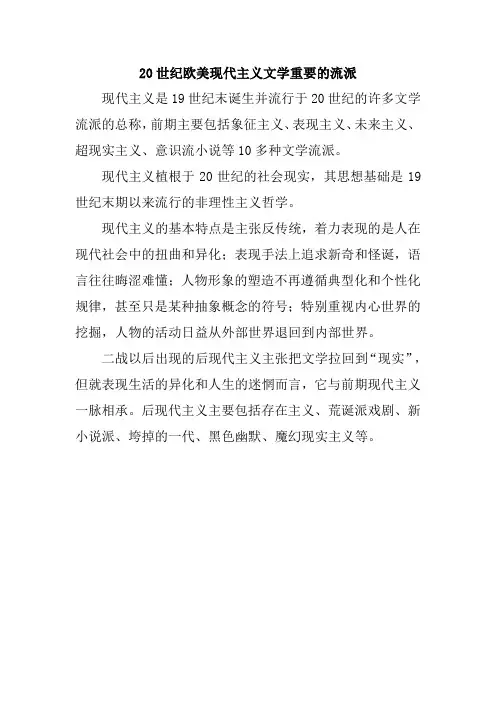
20世纪欧美现代主义文学重要的流派
现代主义是19世纪末诞生并流行于20世纪的许多文学流派的总称,前期主要包括象征主义、表现主义、未来主义、超现实主义、意识流小说等10多种文学流派。
现代主义植根于20世纪的社会现实,其思想基础是19世纪末期以来流行的非理性主义哲学。
现代主义的基本特点是主张反传统,着力表现的是人在现代社会中的扭曲和异化;表现手法上追求新奇和怪诞,语言往往晦涩难懂;人物形象的塑造不再遵循典型化和个性化规律,甚至只是某种抽象概念的符号;特别重视内心世界的挖掘,人物的活动日益从外部世界退回到内部世界。
二战以后出现的后现代主义主张把文学拉回到“现实”,但就表现生活的异化和人生的迷惘而言,它与前期现代主义一脉相承。
后现代主义主要包括存在主义、荒诞派戏剧、新小说派、垮掉的一代、黑色幽默、魔幻现实主义等。
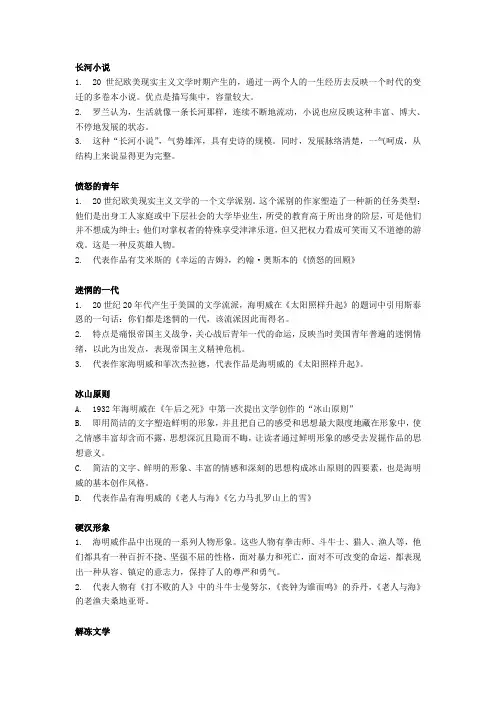
长河小说1.20世纪欧美现实主义文学时期产生的,通过一两个人的一生经历去反映一个时代的变迁的多卷本小说。
优点是描写集中,容量较大。
2.罗兰认为,生活就像一条长河那样,连续不断地流动,小说也应反映这种丰富、博大、不停地发展的状态。
3.这种“长河小说”,气势雄浑,具有史诗的规模。
同时,发展脉络清楚,一气呵成,从结构上来说显得更为完整。
愤怒的青年1.20世纪欧美现实主义文学的一个文学派别。
这个派别的作家塑造了一种新的任务类型:他们是出身工人家庭或中下层社会的大学毕业生,所受的教育高于所出身的阶层,可是他们并不想成为绅士;他们对掌权者的特殊享受津津乐道,但又把权力看成可笑而又不道德的游戏。
这是一种反英雄人物。
2.代表作品有艾米斯的《幸运的吉姆》,约翰·奥斯本的《愤怒的回顾》迷惘的一代1.20世纪20年代产生于美国的文学流派,海明威在《太阳照样升起》的题词中引用斯泰恩的一句话:你们都是迷惘的一代,该流派因此而得名。
2.特点是痛恨帝国主义战争,关心战后青年一代的命运,反映当时美国青年普遍的迷惘情绪,以此为出发点,表现帝国主义精神危机。
3.代表作家海明威和菲次杰拉德,代表作品是海明威的《太阳照样升起》。
冰山原则A.1932年海明威在《午后之死》中第一次提出文学创作的“冰山原则”B.即用简洁的文字塑造鲜明的形象,并且把自己的感受和思想最大限度地藏在形象中,使之情感丰富却含而不露,思想深沉且隐而不晦,让读者通过鲜明形象的感受去发掘作品的思想意义。
C.简洁的文字、鲜明的形象、丰富的情感和深刻的思想构成冰山原则的四要素,也是海明威的基本创作风格。
D.代表作品有海明威的《老人与海》《乞力马扎罗山上的雪》硬汉形象1.海明威作品中出现的一系列人物形象。
这些人物有拳击师、斗牛士、猎人、渔人等,他们都具有一种百折不挠、坚强不屈的性格,面对暴力和死亡,面对不可改变的命运,都表现出一种从容、镇定的意志力,保持了人的尊严和勇气。
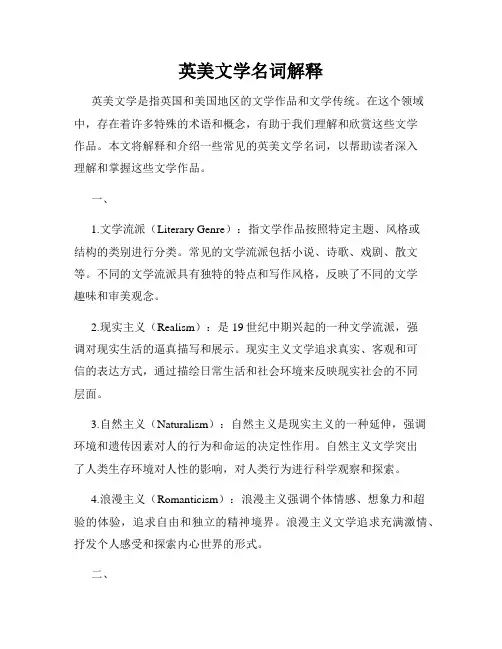
英美文学名词解释英美文学是指英国和美国地区的文学作品和文学传统。
在这个领域中,存在着许多特殊的术语和概念,有助于我们理解和欣赏这些文学作品。
本文将解释和介绍一些常见的英美文学名词,以帮助读者深入理解和掌握这些文学作品。
一、1.文学流派(Literary Genre):指文学作品按照特定主题、风格或结构的类别进行分类。
常见的文学流派包括小说、诗歌、戏剧、散文等。
不同的文学流派具有独特的特点和写作风格,反映了不同的文学趣味和审美观念。
2.现实主义(Realism):是19世纪中期兴起的一种文学流派,强调对现实生活的逼真描写和展示。
现实主义文学追求真实、客观和可信的表达方式,通过描绘日常生活和社会环境来反映现实社会的不同层面。
3.自然主义(Naturalism):自然主义是现实主义的一种延伸,强调环境和遗传因素对人的行为和命运的决定性作用。
自然主义文学突出了人类生存环境对人性的影响,对人类行为进行科学观察和探索。
4.浪漫主义(Romanticism):浪漫主义强调个体情感、想象力和超验的体验,追求自由和独立的精神境界。
浪漫主义文学追求充满激情、抒发个人感受和探索内心世界的形式。
二、1.象征主义(Symbolism):象征主义是19世纪末20世纪初出现的一种文学和艺术运动,强调使用象征性的意象和隐喻来表达深层的情感和思想。
象征主义文学倾向于表达个体的情感体验和心灵探索。
2.现代主义(Modernism):现代主义是20世纪初兴起的一种文学和艺术运动,强调对传统形式和观念的挑战和颠覆。
现代主义文学追求形式上的创新和实验,探索自我意识、哲学思考和社会变革。
3.后现代主义(Postmodernism):后现代主义是现代主义的继承和超越,强调文化多样性、相对主义和戏仿。
后现代主义文学打破传统的叙事和结构规则,以戏仿和颠覆的方式探索权力、真实性和历史观念。
4.现实主义小说(Realistic Novel):现实主义小说以真实的描写和社会批判为特征,通过塑造现实人物的经历和命运来反映社会问题。
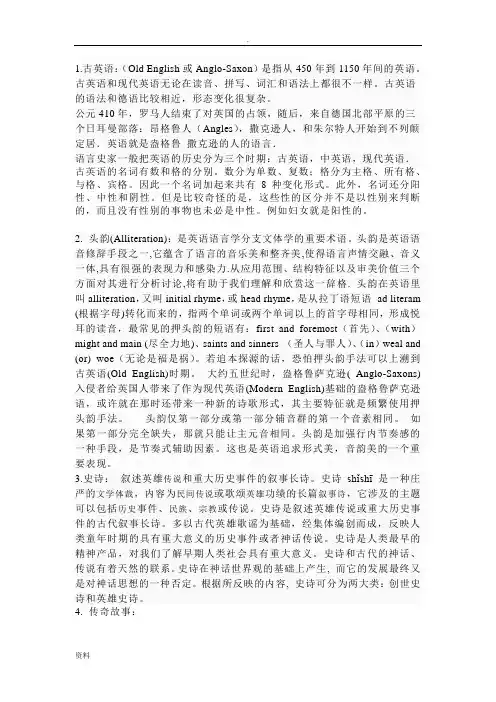
1.古英语:(Old English或Anglo-Saxon)是指从450年到1150年间的英语。
古英语和现代英语无论在读音、拼写、词汇和语法上都很不一样。
古英语的语法和德语比较相近,形态变化很复杂。
公元410年,罗马人结束了对英国的占领,随后,来自德国北部平原的三个日耳曼部落:昂格鲁人(Angles),撒克逊人,和朱尔特人开始到不列颠定居.英语就是盎格鲁_撒克逊的人的语言.语言史家一般把英语的历史分为三个时期:古英语,中英语,现代英语.古英语的名词有数和格的分别。
数分为单数、复数;格分为主格、所有格、与格、宾格。
因此一个名词加起来共有8种变化形式。
此外,名词还分阳性、中性和阴性。
但是比较奇怪的是,这些性的区分并不是以性别来判断的,而且没有性别的事物也未必是中性。
例如妇女就是阳性的。
2. 头韵(Alliteration):是英语语言学分支文体学的重要术语。
头韵是英语语音修辞手段之一,它蕴含了语言的音乐美和整齐美,使得语言声情交融、音义一体,具有很强的表现力和感染力.从应用范围、结构特征以及审美价值三个方面对其进行分析讨论,将有助于我们理解和欣赏这一辞格. 头韵在英语里叫alliteration,又叫initial rhyme,或head rhyme,是从拉丁语短语ad literam (根据字母)转化而来的,指两个单词或两个单词以上的首字母相同,形成悦耳的读音,最常见的押头韵的短语有:first and foremost(首先)、(with)might and main (尽全力地)、saints and sinners (圣人与罪人)、(in)weal and (or) woe(无论是福是祸)。
若追本探源的话,恐怕押头韵手法可以上溯到古英语(Old English)时期。
大约五世纪时,盎格鲁萨克逊( Anglo-Saxons)入侵者给英国人带来了作为现代英语(Modern English)基础的盎格鲁萨克逊语,或许就在那时还带来一种新的诗歌形式,其主要特征就是频繁使用押头韵手法。
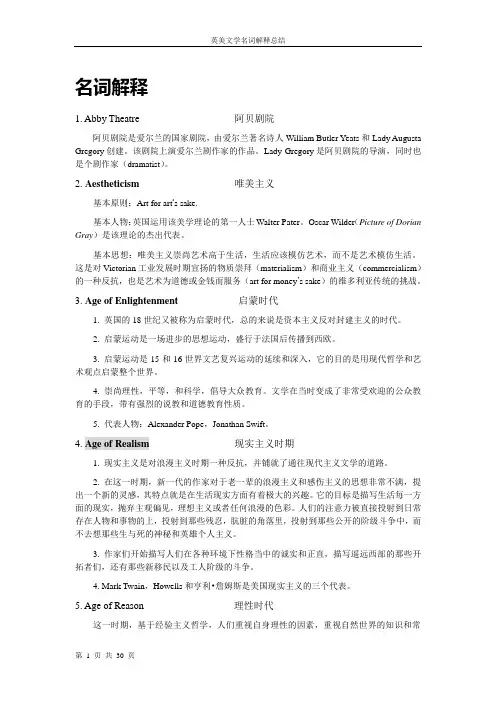
名词解释1. Abby Theatre 阿贝剧院阿贝剧院是爱尔兰的国家剧院,由爱尔兰著名诗人William Butler Yeats和Lady Augusta Gregory创建。
该剧院上演爱尔兰剧作家的作品。
Lady Gregory是阿贝剧院的导演,同时也是个剧作家(dramatist)。
2.Aestheticism 唯美主义基本原则:Art for art’s sake.基本人物:英国运用该美学理论的第一人士Walter Pater。
Oscar Wilder(Picture of Dorian Gray)是该理论的杰出代表。
基本思想:唯美主义崇尚艺术高于生活,生活应该模仿艺术,而不是艺术模仿生活。
这是对Victorian工业发展时期宣扬的物质崇拜(materialism)和商业主义(commercialism)的一种反抗,也是艺术为道德或金钱而服务(art for money’s sake)的维多利亚传统的挑战。
3. Age of Enlightenment 启蒙时代1. 英国的18世纪又被称为启蒙时代,总的来说是资本主义反对封建主义的时代。
2. 启蒙运动是一场进步的思想运动,盛行于法国后传播到西欧。
3. 启蒙运动是15和16世界文艺复兴运动的延续和深入,它的目的是用现代哲学和艺术观点启蒙整个世界。
4. 崇尚理性,平等,和科学,倡导大众教育。
文学在当时变成了非常受欢迎的公众教育的手段,带有强烈的说教和道德教育性质。
5. 代表人物:Alexander Pope,Jonathan Swift。
4. Age of Realism现实主义时期1. 现实主义是对浪漫主义时期一种反抗,并铺就了通往现代主义文学的道路。
2. 在这一时期,新一代的作家对于老一辈的浪漫主义和感伤主义的思想非常不满,提出一个新的灵感,其特点就是在生活现实方面有着极大的兴趣。
它的目标是描写生活每一方面的现实,抛弃主观偏见,理想主义或者任何浪漫的色彩。
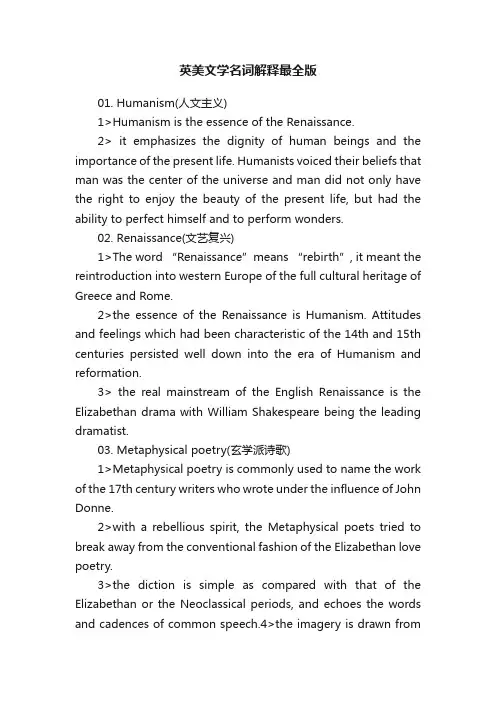
英美文学名词解释最全版01. Humanism(人文主义)1>Humanism is the essence of the Renaissance.2> it emphasizes the dignity of human beings and the importance of the present life. Humanists voiced their beliefs that man was the center of the universe and man did not only have the right to enjoy the beauty of the present life, but had the ability to perfect himself and to perform wonders.02. Renaissance(文艺复兴)1>The word “Renaissance”means “rebirth”, it me ant the reintroduction into western Europe of the full cultural heritage of Greece and Rome.2>the essence of the Renaissance is Humanism. Attitudes and feelings which had been characteristic of the 14th and 15th centuries persisted well down into the era of Humanism and reformation.3> the real mainstream of the English Renaissance is the Elizabethan drama with William Shakespeare being the leading dramatist.03. Metaphysical poetry(玄学派诗歌)1>Metaphysical poetry is commonly used to name the work of the 17th century writers who wrote under the influence of John Donne.2>with a rebellious spirit, the Metaphysical poets tried to break away from the conventional fashion of the Elizabethan love poetry.3>the diction is simple as compared with that of the Elizabethan or the Neoclassical periods, and echoes the words and cadences of common speech.4>the imagery is drawn fromactual life.04. Classicism(古典主义)Classicism refers to a movement or tendency in art, literature, or music that reflects the principles manifested in the art of ancient Greece and Rome. Classicism emphasizes the traditional and the universal, and places value on reason, clarity, balance, and order. Classicism, with its concern for reason and universal themes, is traditionally opposed to Romanticism, which is concerned with emotions and personal themes.05. Enlightenment(启蒙运动)1>Enlightenment movement was a progressive philosophical and artistic movement which flourished in France and swept through western Europe in the 18th century.2> the movement was a furtherance of the Renaissance from 14th century to the mid-17th century.3>its purpose was to enlighten the whole world with the light of modern philosophical and artistic ideas.4>it celebrated reason or rationality, equality and science. It advocated universal education.5>famous among the great enlighteners in England were those great writers like Alexander pope. Jonathan Swift. etc.06.Neoclassicism(新古典主义)1>In the field of literature, the enlightenment movement brought about a revival of interest in the old classical works.2>this tendency is known as neoclassicism. The Neoclassicists held that forms of literature were to be modeled after the classical works of the ancient Greek and Roman writers such as Homer and Virgil and those of the contemporary French ones.3> they believed that the artistic ideals should be order, logic,restrained emotion and accuracy, and that literature should be judged in terms of its service to humanity.07. The Graveyard School(墓地派诗歌)1>The Graveyard School refers to a school of poets of the 18th century whose poems are mostly devoted to a sentimental lamentation or meditation on life. Past and present ,with death and graveyard as themes.2>Thomas Gray is considered to be the leading figure of this school and his Elegy written in a country churchyard is its most representative work.08. Romanticism(浪漫主义)1>In the mid-18th century, a new literary movement called romanticism came to Europe and then to England.2>It was characterized by a strong protest against the bondage of neoclassicism, which emphasized reason, order and elegant wit. Instead, romanticism gave primary concern to passion, emotion, and natural beauty.3>In the history of literature. Romanticism is generally regarded as the thought that designates a literary and philosophical theory which tends to see the individual as the very center of all life and experience. 4> The English romantic period is an age of poetry which prevailed in England from 1798 to 1837. The major romantic poets include Wordsworth, Byron and Shelley.09. Byronic Hero(拜伦式英雄)1>Byronic hero refers to a proud, mysterious rebel figure of noble origin.2> with immense superiority in his passions and powers, this Byronic Hero would carry on his shoulders the burden of righting all the wrongs in a corrupt society. And would rise single-handedly against any kind of tyrannical rules either in government, in religion, or in moral principles with unconquerable wills and inexhaustible energies.3> Byron’s chief contribution to English literature is his creation of the “Byronic Hero”10. Critical Realism(批判现实主义)1>Critical Realism is a term applied to the realistic fiction in the late 19th and early 20th centuries.2> It means the tendency of writers and intellectuals in the period between 1875 and 1920 to apply the methods of realistic fiction to the criticism of society and the examination of social issues.3> Realist writers were all concerned about the fate of the common people and described what was faithful to reality.4> Charles Dickens is the most important critical realist.11. Aestheticism(美学主义)1>The basic theory of the Aesthetic movement--- “art for art’s sake” was set forth by a French poet, Theophile Gautier, the first Englishman who wrote about the theory of aestheticism was Walter Pater.2> aestheticism places art above life, and holds that life should imitate art, not art imitate life.3> According to the aesthetes, all artistic creation is absolutely subjective as opposed to objective. Art should be free from any influence of egoism. Only when art is for art’s sake, can it be immortal. They believed that art should be unconcerned with controversial issues, such as politics and morality, and that it should be restricted to contributing beauty in a highly polished style.4> This is one of the reactions against the materialism andcommercialism of the Victorian industrial era, as well as a reaction against the Victorian convention of art for morality’s sake, or art for money’s sake.美学运动的基本原则”为艺术而艺术”最初由法国诗人西奥费尔.高缔尔提出,英国运用该美学理论的第一人是沃尔特.佩特.美学主义崇尚艺术高于生活,认为生活应模仿艺术,而不是艺术模仿生活.在美学主义看来,所有的艺术创作都是绝对主观而非客观的产物.艺术不应受任何功利的影响,只有当艺术为艺术而创作时,艺术才能成为不朽之作.他们还认为艺术不应只关注一些热点话题如政治和道德问题,艺术应着力于以华丽的风格张扬美.这是对维多利亚工业发展时期物质崇拜的一种回应,也是向艺术为道德或为金钱而服务的维多利亚传统的挑战.12.The Victorian period(维多利亚时期)1>In this period, the novel became the most widely read and the most vital and challenging expression of progressive thought. While sticking to the principle of faithful representation of the 18th century realist novel, novelists in this period carried their duty forward to criticism of the society and the defense of the mass.2> although writing from different points of view and with different techniques, they shared one thing in common, that is, they were all concerned about the fate of the common people. They were angry with the inhuman social institutions, the decaying social morality as represented by the money-worship and Utilitarianism, and the widespread misery, poverty and injustice.3>their truthful picture of people’s life and bitter and strong criticism of the society had done much in awakening the public consciousness to the social problems and in the actual improvement of the society.4> Charles Dickens is the leading figure of the Victorianperiod.13. Modernism(现代主义)1>Modernism is comprehensive but vague term for a movement , which begin in the late 19th century and which has had a wide influence internationally during much of the 20th century.2> modernism takes the irrational philosophy and the theory of psycho-analysis as its theoretical case.3> the term pertains to all the creative arts. Especially poetry, fiction, drama, painting, music and architecture.4> in England from early in the 20th century and during the 1920s and 1930s, in America from shortly before the first world war and on during the inter-war period, modernist tendencies were at their most active and fruitful.5>as far as literature is concerned, Modernism reveals a breaking away from established rules, traditions and conventions. fresh ways of looki ng at man’s position and function in the universe and many experiments in form and style. It is particularly concerned with language and how to use it and with writing itself.14. Stream of consciousness(意识流)(or interior monologue)In literary criticism, Stream of consciousness denotes a literary technique whic h seeks to describe an individual’s point of view by giving the written equivalent of the character’s thought processes. Stream of consciousness writing is strongly associated with the modernist movement. Its introduction in the literary context, transferred from psychology, is attributed to May Sinclair. Stream of consciousness writing is usually regarded as a special form of interior monologue and is characterized by associative leaps in syntax and punctuation that can make the prose difficult to follow, tracing as they do a character’sfragmentary thoughts and sensory feelings. Famous writers to employ this technique in the English language include James Joyce and William Faulkner.学术界认为意识流是一种通过直接描述人物思维过程来寻求个人视角的文学写作技巧。

1、表现主义 (1)2、营造幻象 (1)3、虚拟现实 (1)4、意识流: (1)5. 意识流小说 (1)6. 心理时间 (1)8. 自由联想 (1)9. 存在主义 (1)10. 自由选择 (1)11. 荒诞体验 (1)12. 零度写作 (1)13. 新小说派 (1)14. 反小说 (1)15. 人物内心独白中的复调模式 (1)16. 魔幻现实主义 (1)17. 拉美“文学爆炸” (1)18. 魔幻现实主义的“陌生化” (1)19. 黑色幽默 (1)20. 后现代主义 (1)21. 元小说 (1)22. 社会主义现实主义 (1)23. 内心独白 (1)24. 蒙太奇 (1)25. 消解深度 (1)26. 瓦解叙事 (1)27. 物化 (1)28. 超现实主义 (1)29. 潜对话(或叫做人物内心狐白中的复调模式) (1)1、表现主义:“表现”的概念最初是运用在绘画评论中,表现主义是一种反传统的现代主义的流派,它在绘画、文学、音乐、电影等艺术形式中均有不同的表现。
“但他们也有一些共同的想想倾向和艺术特点,即不满足于对客观事物的摹写,要求进而表现事物的内在实质:要求突破对人的行为和人所外的环境的描绘而提示人的灵魂;要求不再停留在对暂时现象的偶然现象的记叙而展示其永恒的品质”。
2、营造幻象:营造幻象是卡夫小说创作的方法与特点。
他的小说在总体上呈现出一个超现实的世界,一个想象的梦幻的世界,一个并不存在的荒诞世界。
这个幻象的世界看似不合逻辑但却并非虚妄,揭示了人类生存更本真的图景。
3、虚拟现实:虚拟现实也是卡夫卡小说创作的方不可能存在,但又合逻辑上的存在的可能性的现实,是未必发生却可能发生的情境。
4、意识流:“意识流”这一概念最初是心理学术语,是由美国心理学家威谦·詹姆斯在《心理学原理》一书中提出来的。
梅·辛克莱在评论多萝西·理查逊的小说《旅程》时,最早把“意识流”这一术语引入了文学评论,此后,作为一个文学术语的“意识流”被文学家们广泛运用,前通告三层意思:一、指一个现代主义小说流派;二、一种小说文体;三、表现人物心理和意识活动的一种技巧。
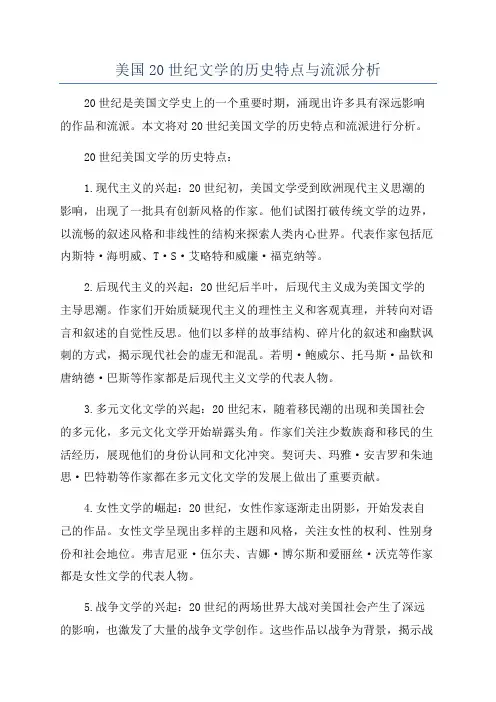
美国20世纪文学的历史特点与流派分析20世纪是美国文学史上的一个重要时期,涌现出许多具有深远影响的作品和流派。
本文将对20世纪美国文学的历史特点和流派进行分析。
20世纪美国文学的历史特点:1.现代主义的兴起:20世纪初,美国文学受到欧洲现代主义思潮的影响,出现了一批具有创新风格的作家。
他们试图打破传统文学的边界,以流畅的叙述风格和非线性的结构来探索人类内心世界。
代表作家包括厄内斯特·海明威、T·S·艾略特和威廉·福克纳等。
2.后现代主义的兴起:20世纪后半叶,后现代主义成为美国文学的主导思潮。
作家们开始质疑现代主义的理性主义和客观真理,并转向对语言和叙述的自觉性反思。
他们以多样的故事结构、碎片化的叙述和幽默讽刺的方式,揭示现代社会的虚无和混乱。
若明·鲍威尔、托马斯·品钦和唐纳德·巴斯等作家都是后现代主义文学的代表人物。
3.多元文化文学的兴起:20世纪末,随着移民潮的出现和美国社会的多元化,多元文化文学开始崭露头角。
作家们关注少数族裔和移民的生活经历,展现他们的身份认同和文化冲突。
契诃夫、玛雅·安吉罗和朱迪思·巴特勒等作家都在多元文化文学的发展上做出了重要贡献。
4.女性文学的崛起:20世纪,女性作家逐渐走出阴影,开始发表自己的作品。
女性文学呈现出多样的主题和风格,关注女性的权利、性别身份和社会地位。
弗吉尼亚·伍尔夫、吉娜·博尔斯和爱丽丝·沃克等作家都是女性文学的代表人物。
5.战争文学的兴起:20世纪的两场世界大战对美国社会产生了深远的影响,也激发了大量的战争文学创作。
这些作品以战争为背景,揭示战争对个体心灵和社会生活的摧毁以及人性的善恶。
约瑟夫·海勒和库尔特·冯内古特等作家通过他们笔下的战争故事,带领读者反思和思考。
20世纪美国文学的流派分析:1.自然主义文学:19世纪末至20世纪初,自然主义文学在美国迅速兴起。
二十世纪文学名词解释(一)现代主义1.现代主义(先锋派文学)2.后期象征主义3.未来主义4.超现实主义5.表现主义文学6.叙事剧与间离效果7.意识流小说8.存在主义文学9.荒诞派戏剧10.新小说派11.黑色幽默12.魔幻现实主义13.卡夫卡小说14.境遇剧1.现代主义是十九世纪末二十世纪初以来在欧美出现的各种文学艺术思潮流派的总称(1分).它是西方垄断资本主义时代的产物,从不同角度反映了现当代资本主义社会的危机与人的精神迷惘、困惑(1分)。
在思想内容、审美追求与表现形式上都表现出反传统的倾向。
具有标新立异、大胆实验、追求奇异的风格特点。
故称为先锋派、实验派。
重要流派有:超现实主义、意识流小说、荒诞派戏剧等(1分)。
2.二十世纪二十年代以瓦雷里、里尔克、艾略特为代表的诗歌流派(1分),是十九世纪末象征主义的继续和发展。
创作上主张用象征、暗示、意象、比喻、自由联想等手法表现微妙复杂的体验与主观感受(2分),较前期象征主义更趋哲理化与神秘性(1分)。
代表作家作品:艾略特《荒原》、瓦雷里、里尔克《杜伊诺哀歌》(1分)。
3.二十世纪源于意大利,影响整个欧洲的诗歌流派(1分)。
其基本特征是:否定一切,主张彻底废除一切艺术遗产与传统文化,主张变革,歌颂混乱、速度美、力量美,用自由不羁的语句颠覆传统艺术规范,具有虚无主义、无政府主义倾向(2分)。
代表人物:马里内蒂、帕拉采斯基(1分)。
4.两次世界大战期间源于法国影响欧美的文学流派(1分),主张表现超现实、超理性的无意识心理、梦幻世界,用纯精神的自动反应进行写作(2分)。
最大限度展示自我的内在真实。
具有神秘晦涩的特点(1分)。
主要代表人物有布勒东、阿拉贡、艾吕雅(1分)。
5.第一次世界大战后源于法国影响欧美的现代主义文学流派(1分),创作上强调表现主观感受,注重内在心灵、感觉体验的表现,主张透过事物的表面揭示内在本质,不注重环境写实与性格刻画(2分)。
表现手法多采用象征、隐喻、抽象、夸张、变形以突出主观感受(2分).代表人物有卡夫卡、斯特林斯堡、恰佩克等。
外国文学史(下)三大板块,众多流派20世纪上半叶是现实主义与现代主义;20世纪下半叶进入后现代主义时代。
1、20世纪现实主义文学20世纪现实主义(Realism)是19世纪现实主义文学的继续和发展。
20世纪现实主义主要流派:长河小说——罗曼·罗兰《约翰.克利斯朵夫》、肖洛霍夫《静静的顿河》;迷惘的一代——海明威《太阳照样升起》;心理小说——劳伦斯《儿子与情人》《虹》。
2、现代主义文学modernism是20世纪上半叶流行于欧美文坛的资产阶级文艺思潮,也是当代西方世界社会危机、精神危机和艺术危机在文艺领域的反映。
一般认为:19世纪末—20世纪初:现代主义的酝酿期;1910年至1930年:现代主义的高峰期;1930-1950年:现代主义的衰落期;(1)现代主义文学的思想特点:现代主义文学关注人性和人的生存状况,尖锐批判西方现代社会的荒谬性及其对人性的扭曲和异化(人与自然、人与社会、人与物质、人与自我的对立。
),着重表现人的内心生活和心理真实。
现代主义文学实现了写作主题从世界向人、从客观向主观、从外向内的转变,人、主体、自我、内心成了现代文学的中心。
(2)现代主义文学的艺术特点:A.象征性。
借助意象,用暗喻、烘托、渲染等手法,探求人物的内心真实,把思想还原为知觉,使抽象的思想外化。
B.荒诞性。
通过非理性的极度夸张的形式,将现实与非现实糅合在一起,寓严肃于荒诞。
荒诞形象具有一种特殊的概括力。
C.意识流。
大量采用“内心独白”、“自由联想”的手法,挖掘人的潜意识,表现人物意识“自然”流动状态,力求开掘人物心理的复杂性。
(3)现代主义文学的主要流派:意象主义——庞德《在地铁车站》后期象征主义——艾略特《荒原》;未来主义、达达主义和超现实主义;表现主义——卡夫卡《变形记》、奥尼尔《毛猿》;意识流小说——乔伊斯《尤利西斯》、福克纳《喧哗与骚动》。
3、后现代主义文学Post—modernism是一场发生于欧美60年代,并于70与80年代流行于西方的艺术、社会文化与哲学思潮,它是信息时代的产物。
英美文学史名词解释
英美文学史是研究英国和美国的文学发展及其作品的学科。
在这个领域中,有许多重要的名词需要解释和拓展。
以下是其中几个关键的名词解释:
1. 古典主义:指的是17世纪至18世纪初期的文艺复兴时期,以古希腊和古罗马文化为基础的艺术和文学风格。
这一时期的作品强调对古典文学的借鉴,追求理性、秩序和对称。
2. 浪漫主义:指的是18世纪末至19世纪初期的文学和艺术运动,强调个人情感、幻想和对自然的热爱。
浪漫主义作品追求超越现实的境界,注重情感表达和个人体验。
3. 现实主义:19世纪中期至20世纪初期的文学流派,强调对现实生活的描写和分析。
现实主义作品试图通过真实和客观的方式呈现社会问题和人类经验,反映现实世界的复杂性。
4. 自然主义:19世纪末至20世纪初期的文学流派,强调环境和遗传对人性的影响。
自然主义作品探讨人类行为和性格的原因,强调环境和遗传因素对人们的决定性作用。
5. 现代主义:20世纪初期至中期的文学运动,突破传统的文学形式和观念。
现代主义作品倾向于使用非线性结构、流派交叉和意识流等实验性的写作技巧,探
索意识、时间和现代社会的复杂性。
除了这些名词,还有许多其他重要的概念和作品,如文艺复兴、启蒙运动、维多利亚时代、现代派诗歌、战争文学等。
研究英美文学史可以帮助我们了解不同时期的文学发展和作品背后的思想、价值观和文化背景。
一.名词解释1.意识流(stream of consciousness)The continuous flow of sense, perc eptions, thoughts, feelings, and memories in the human mind; or a li terary method of representing such a blending of mental processes in fictional characters, usually in an unpunctuated or disjointed for m of interior monologue.2.荒诞派戏剧(The Theatre of the Absurd)The theatre of the absurd c ame about as a reaction to World War II. It took the basis of existe ntial philosophy and combined it with dramatic elements to create a style of theatre which presented a world which can not be logically explained, and in which life is in one word, ABSURD!3.存在主义哲学(Existentialism)A current in European philosophy dis tinguished by its emphasis on lived human existence4.迷惘的一代(the lost generation)In general, the term refers to the post-World War I generation, but specifically a group of U. S. wri ters who came of age during the war and established their literary r eputations in the 1920s.5.戏仿(parody)A mocking or satiric imitation of the style of a lit erary work or works, ridiculing the stylistic habits of an author ora school by exaggerated mimicry.6.象征主义(symbolism) Symbolism is the use of symbols to represent abstract things, ideas or conceptions in a more visual and concrete way.7.恋母情结( Oedipus complex) A Freudian term to design to attractio n on the part of the child toward the parent of the opposite sex and rivalry and hostility toward the parent of its own.The term derives from the Theban hero Oedipus of Greek legend. It will lead to resen tment of parental authoritarian power.8.海明威式英雄( Hemingway hero)Hemingway Hero, also called code her o, is one who, wounded but strong, more sensitive, enjoys the pleasu res of life(sex, alcohol, sport) in the face of ruin and death, and maintains, through some notion of a code, an ideal of himself.9.美国梦(American dream)American dream refers to the dream of mater ial success, which assume that one best serves God and man by acquir ing wealth.10.意象派(Imagism)The doctrine and poetic practice of a small but influential group of American and British poets calling themselves i magists or imagistes between 1912 and 1917.11.黑色幽默(black humor)black humor is a term applied to a large g roup of American novels beginning in the 1950s,it's a common core of satire which is directed against hypocrisy, materialism, racial pre judice, and above all, the dehumanization of the individual by a mod ern society. It is not angry protest,is the use of exaggeration as a vehicle for satire and criticism. It is humor out of despair and la ughter out of tears.12.女权主义(feminism)Feminism is the belief that women should h ave equal political, social, sexual, intellectual and economic right s to men. It involves various movements, theories, and philosophies, all concerned with issues of gender difference, that advocate equal ity for women and that campaign for women's rights and interests 13.反英雄(anti-hero)an anti-hero is a protagonist who is lacking t he traditional heroic attributes and qualities, and instead possesse s character traits that are antithetical to heroism.14.多个故事叙述人(multiple narrators)It is one of the literary tec hniques William Faulkner used, which shows within the same story how the characters reacted differently to the same person or the same s ituation. The use of this technique gave the story a circular form w herein one event was the center, with various points of view radiati ng from it. The multiple points of view technique makes the reader r ecognize the difficulty of arriving at a true judgment.15.拼贴(collage)Collage is the method of making pictures by sticki ng pieces of colored paper and cloth onto paper.Symbolism 象征主义late 19th century and early 20th century poetry.William Butler Yeats Symbolism 象征主义 born in Dublin,his mothe r in Sligo County,stduy in London IrishModernism 现代主义Major Works《Down by the Salley Gardens》《The Second Coming》 Anti-christ save the people in the world bring the disaster《When You Are Old》《The Wild Swans at Coole》《Leda and the Swan》 swan is power Leda has to give in .Major Themeslovethe Irish nationalist movementcollapse of western civilizationphilosophy of history and personalityParadoxes of time and change, of growth and identity, of love and ag e, of life and art, of madness and wisdomTechniquescombination of metaphysical and epigrammatic elementsIntroduction of the Irish usages of English and Irish syntax Experiment with different kinds of rhythmRealistic, symbolic and visionaryPercy Bysshe Shelley Symbolism 象征主义英国人《The Necessity of Atheism》《Queen Mab》《The Revolt of Islam》《To A Skylark》《Prometheus Unbound》《The Masque of Anarchy》《Ode to the West Wind》《A Defence of Poetry》T.S Eliot Symbolism 象征主义Born Am 英国籍 the Nobel Prize in 1948major symbols including the waste land, water, city, stairs, journe y; the themes of time, death, rebirth, loveMajor works《The family reunion》《Four Quartets》《The Love Song of J. Alfred Prufrock》 anti-hero hesitating to go o r not to go to see his girlfriend(indecisive,hesitant)《The Waste Land 》小 London 大 Westen 借鉴了Miss Jessie《from Ritual to Romance》从仪式到传奇和James Frazer《Gold Bough》金枝典故:鱼王的传说、基督教寻找圣杯的传说、纸牌的传说一the burialof the dead二a game of class三the fire sermon四 death by water 五 what the thunder said讽刺冬天温暖 death; lonely nothing don’t want children;corrupti on腐败堕落;不计得失;search water,see sea but no hope 。
美国20世纪文学的历史特点与流派分析20世纪,是美国文学史上最为繁荣、多元化的时期。
多种不同的文学流派在此时兴起并受到广泛关注,这些流派代表了不同的文化、社会与政治观点,而本文的目的就是对这些文学流派进行探讨和分析。
一、自然主义文学自然主义文学是美国20世纪早期的一种文学流派。
它强调人类受环境和遗传因素的影响,认为人类无法逃脱自身的本性。
该流派的作品常常描述人类在恶劣环境中的境遇,表现出生活在城市贫民窟和工厂中的人们的苦难和生存状态。
美国作家菲利普·韦斯特在《三毛猫》中通过对小人物命运的描写,展示了自然主义文学的主要特色:人物命运悲惨、常常受到外界环境和遗传因素的限制,他们往往面临着无法逃脱的命运的困境。
二、现代主义文学20世纪中期,出现了现代主义文学这一全新的文学流派。
现代主义文学强调形式的创新、将文学视为一种艺术表现形式。
作家们通常采用象征主义等手法,通过扭曲的形式、不连续的叙述和旁白等技巧,表现一种缺失感和审美主义。
例如,欧内斯特·海明威在《老人与海》(The Old Man and the Sea)中描述的老渔夫就成为了现代主义文学中的代表人物。
小说描绘了老渔夫独自乘船出海,最终捕到了一条巨大的鱼的故事。
这一作品以其深刻的人物心理描写、含蓄的艺术形式和复杂的象征主义内涵,使其成为了现代主义文学的代表作品。
三、后现代主义文学在20世纪70年代后期,后现代主义文学开始成为主流文学流派之一。
后现代主义文学通常不注重故事线的逻辑、情节的连贯性和传统的文学习惯。
作者会采取多种文学形式,例如碎片化的文字、错位的时间和空间、多方面的叙述等等,让读者在众多形式中自行建立连续的故事线。
著名的后现代小说家托马斯·品钦(Thomas Pynchon)在其作品《重力彩虹》(Gravity's Rainbow)中采用了多元的叙述方式,通过对人物的多重角度描写,以及连续不断的突然转换叙述位置,使作品变得非常复杂和有趣。
1、俄林波斯神系俄林波斯神系是希腊神话中神的故事的一部分。
神的故事包括天地的开辟、神和人的起源、四季的成因、动植物的出现,以及以宙斯为首的俄林波斯神族成员的活动。
古希腊人按照人的形象创造了神,并认为天上也和人间一样有一个神的大家庭,因其居住在希腊北部的俄林波斯山上而称为俄林波斯神系。
主要的神有神王宙斯,神后赫拉,宙斯的哥哥冥王哈得斯、海神波塞冬,还有宙斯的儿子太阳神阿波罗、战神阿瑞斯、工匠之神赫淮斯托斯,女儿智慧女神雅典娜、爱神和美神阿佛洛狄忒。
此外,还有9个缪斯是文艺女神,3个摩伊勒是命运女神。
2、荷马史诗荷马史诗包括《伊利亚特》和《奥德修纪》两部史诗,取材于公元前12世纪发生的特洛亚战争的历史事件,有相当长的民间传唱和吟诵过程。
公元前9世纪左右,相传由行吟诗人荷马编订完成,故名荷马史诗。
公元前6世纪由学者用文字写定。
《伊利亚特》的主题是赞美古代英雄的刚强威武、机智勇敢,讴歌他们英雄主义和集体主义精神。
《奥德修纪》讴歌了古代英雄在同自然力的抗争中所体现出来的机智勇敢和坚强意志,表达了主人公对部落集体和乡土的眷恋之情。
两部史诗结构巧妙、形象鲜明、语言质朴、比喻奇特,并具有各自不同的艺术风格。
荷马史诗真实地反映了古代希腊从原始公社制向奴隶制过渡时期的社会风貌,是认识希腊史前社会的重要文献。
3、古希腊抒情诗古希腊抒情诗盛行于公元前7世纪至公元前5世纪,大多用来歌唱。
它源于民歌,分为箫歌(或称哀歌)、琴歌和讽刺诗几种,分别以排箫或竖琴伴唱。
诗的内容主要是歌颂神和英雄、赞美爱情等。
最著名的是女诗人萨福,她的诗篇大多抒发恋爱的欢乐和痛苦,友谊和母爱的可贵,风格细腻,感情真挚。
其他著名诗人还有阿那克瑞翁和品达罗斯。
前者所写诗篇大多赞美自然风光和真挚爱情,诗体清新、优美;后者多讴歌神和英雄,诗风庄重崇高。
4、伊索寓言伊索寓言是希腊民间口头流传的动物寓言故事,相传为公元前6世纪时被释放的奴隶伊索所作,故称伊索寓言。
1、stream of consciousnessThe continuous flow of sense, perceptions, thoughts, feelings, and memories in the human mind; or a literary method of representing such a blending of mental processes in fictional characters, usually in an unpunctuated or disjointed form of interior monologue.The term is often used as a synonym for interior monologue, but they can also be distinguished, in two ways. In the first (psychological) sense, the stream of consciousness is the subject-matter while interior monologue is the technique for presenting it;2、The Theatre of the AbsurdA term coined by the critic Martin Esslin in 1961 to refer to a number of dramatists of the 1950s. The theatre of the absurd came about as a reaction to World War II. It took the basis of existential philosophy and combined it with dramatic elements to create a style of theatre which presented a world which can not be logically explained, and in which life is in one word, ABSURD!3、ExistentialismA current in European philosophy distinguished by its emphasis on lived human existence. Although it had an important precursor先驱on the Danish theologian神学者Kierkegaard in the 1840s, its impact was fully felt only in the mid-20th century in France and Germany: the German philosophers Martin Heidegger and Karl Jaspers prepared some of the ground in the 1920s and 1930s for the more influential work of Jean-Paul Sartre and the other French existentialists including Simone de Beauvoir, Albert Camus, and Maurice Merleau-Ponty.4、The Lost Generation(Also termed the Sad Young Men, which was created by F. Scott Fitzgerald in his book All the Sad Young Men.) In general, the term refers to the post-World War I generation, but specifically a group of U. S. writers who came of age成年,够岁数了during the war and established their literary reputations in the 1920s. It seems from a remark made by Gertrude Stein to Ernest Hemingway, “You are all a lost generation.” Hemingway used it as an epigraph题词to The Sun Also Rises (1926), a novel that captures the attitudes of a hard-drinking, fast-living set of disillusioned young expatriates放弃本国国籍的人in postwar Paris.The generation was “lost” in the sense that its spiritual alienation from a U. S. that, basking under President Harding’s “back to normalcy常态” policy, seem ed to its members to be hopelessly provincial, materialistic, and emotionally barren. The term embraces Hemingway, F. Scott Fitzgerald, John Dos Passos, E. E. Cummings, and many other writers who made Paris the center of their literary activities in the 1920s. They were never a literary school. In the 1930s, as these writers turned in different directions, their works lost the distinctive stamp of the postwar period.5、Parodypiece of) writing intended to amuse by imitating the style of writing used by somebody else. Literary or musical composition imitating the characteristic style of some other work or of a writer or composer, but treating a serious subject in a nonsensical manner, as in ridicule6、SymbolismThe term refers to the use of symbols, or to a set of related symbols; however, it is also the name given to an important movement on late 19th century and early 20th century poetry. One of the important features of Romanticism and succeeding phases of Western literature was a much more pronounced reliance upon enigmatic难以理解的, 神秘的symbolism in both poetry and prose fiction, sometimes involving obscure private codes of meaning, as in the poetry of Blake or Yeats.A well-known early example of this is the albatross信天翁in Ancient Mariner”(1798). Manynovelists-notably Herman Melville and D. H. Lawrence-have used symbolic methods: in Melville’s Moby-Dick(1815) the White Whale (and indeed almost every object and character in the book) becomes a focus for many different suggested meanings. Melville’s extravagant symbolism was encouraged partly by the importance which American Transcendentalism gave to symbolic interpretation of the world.William Butler Yeats often uses symbols like the winding stairs, swan, gyre, etc. in his poems.7、Oedipus Complex 心理学用来比喻有恋母情结的人,有跟父亲作对以竞争母亲的倾向,同时又因为道德伦理的压力,而有自我毁灭以解除痛苦的倾向A Freudian term to design to attraction on the part of the child toward the parent of the opposite sex and rivalry敌对, 竞争, 对抗and hostility toward the parent of its own. Freud introduced the concept in his Interpretation of Dreams (1899). The term derives from the Theban hero Oedipus of Greek legend, who unknowingly slew his father and married his mother; its female analogue, the Electra complex, is named for another mythological figure, who helped slay her mother.8、Hemingway HeroHemingway Hero, also called code hero, is one who, wounded but strong, more sensitive, enjoys the pleasures of life(sex, alcohol, sport) in the face of ruin and death, and maintains, through some notion of a code, an ideal of himself.9、American dreamAmerican dream refers to the dream of material success, which assume that one best serves God and man by acquiring wealth. In The Great Gatsby, Gatsby comes from the west to the east with the dream of material success. By bootlegging and other illegal means he fulfilled his dream but ended up being killed.10、ImagismThe doctrine and poetic practice of a small but influential group of American and British poets calling themselves imagists or imagistes between 1912 and 1917.Imagism came into being as a reaction to the traditional English poetry to express the sense of fragmentation and dislocation混乱, 紊乱.The Imagists hold that the most effective means to express these momentary impressions is through the use of one dominant image. The image is a representation of a physical object, and the reader is made to react to it.Imagism is characterized by the following three poetic principles:i) to use absolutely no word that does not contribute to the presentation;ii) as regards rhythm, to compose in the sequence of the musical phrase, not in the sequence of metronome节拍器节拍器.11、Black HumorIn contemporary literary criticism, black humor is a term applied to a large group of American novels beginning in the 1950s. Although the writers of black humor did not intentionally form a school of literary movement, there is in their novels a common core of satire which is directed against hypocrisy, materialism, racial prejudice, and above all, the dehumanization of the individual by a modern society12/FeminismFeminism refers to political, cultural ,and economic movements seeking greater, equal ,or among a minority ,superior rights and participation in society for women and girls. These rights and means of participation include legal protection and inclusion in politics ,business and scholarship andrecognition and building of women’s cultures and power. Its concepts overlap with those of women’s rights.13/Anti-heroAn anti-hero/heroine appears more frequently in modern and contemporary literature. This type of characters lacks the qualities of nobility and magnanimity宽宏大量. The image of Don Quixote in Cervantes’s Don Quixote (1605) may give the readers a clear view.14/multi-narrator。